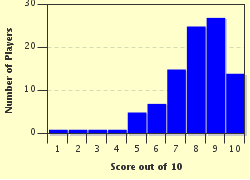Quiz Answer Key and Fun Facts
1. In 1851, Herman Melville published "Moby Dick". Of the many members of the crew of the whaling ship the "Pequod", only one survives. Who is it?
2. Leo Tolstoy's sprawling epic "War and Peace" (1869) tells about the effects of war on Russia. Which war is the focus of the novel?
3. One of the first novels, "The Tale of Genji", was written in the eleventh century. From which nation was the author?
4. Famed author Charles Dickens described this 1849-50 novel as his "favorite child". Which novel was it?
5. "One Thousand and One Nights" is a famous collection of various tales from Southwest and South Asia. Who is the in-story narrator of many of these tales, who is trying to save her own life?
6. "The Three Musketeers" by Alexandre Dumas tells the story of D'Artagnan and his quest to join the Musketeers of the King of France. While his friends and companions are Porthos, Athos, and Aramis, which religious figure is the chief antagonist in the novel?
7. "Les Miserables" is a famous novel by Victor Hugo that is particularly known for the hit musical of the same name. Whether one reads the novel or views the musical, one notices that many of the important characters die during the course of the story. Who is alive at the end?
8. "Mysterious Island" is an 1874 novel by Jules Verne. In it a group of Americans are marooned when their hot air balloon crashes on a remote South Pacific island. While there, they receive aid from an important character from another Jules Verne novel. Who is it?
9. "Don Quixote" is by the Spanish author Miguel de Cervantes. In the novel, the main character, Alonso Quixano, imagines himself something that he is not. What does he imagine himself to be?
10. This novel--featuring the characters Eliza, George, and Simon Legree--was the second best selling book of the nineteenth century. Which novel was it?
Source: Author
bernie73
This quiz was reviewed by FunTrivia editor
looney_tunes before going online.
Any errors found in FunTrivia content are routinely corrected through our feedback system.


